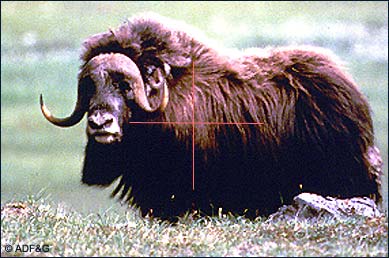|
Muskox Cartridges By Chuck Hawks  The muskox is a strange looking, bad smelling, very furry and shaggy animal that generally inhabits the barren land of the far north. It is a throwback to the Ice Age. It survives in Arctic cold and snow that would kill most other creatures. Muskox hunting in neither easy nor inexpensive, and requires specialized gear to survive the cold. Expect freezing temperatures, especially at night. The muskox is a large, but not gigantic, animal. His very thick and furry coat makes him seem larger than he really is. Edward A. Matunas, in the course of his research into the actual size of big game animals, reported that a mature male muskox averages about 775 pounds on the hoof. Because both bulls and cows are large animals, and both have horns, sex identification can be a problem. The key feature of mature bulls is the complete and heavy horn boss that extends completely across the top of their head. Males also have horns with black tips (if they have not been broken off). Females lack the horn boss, and have thinner horns (about the diameter of a man's thumb) without black tips. Here is an illustration and some words of advice from the Alaska Department of Fish and Game:  "Consider shot placement. Where on this hairy animal will you aim? Find portions of the animal as landmarks through which to draw cross hairs. His rump makes a definite drop. The drop is a good place to start a HORIZONTAL line which will cross through the ribs. His shoulder is highlighted by sun here. You can make a pretty good guess where his front leg is. Come up from that for your vertical crosshair. Don't be fooled by the long skirt of hair hanging below the belly. Hunters who are not experienced with muskoxen sometimes aim too low. It's easier on a live, moving animal. Aim for the chest cavity. Don't hit the hump. Neck shots are a bad idea." Muskox live and travel in groups. Their standard defense to threats is to bunch up. Be careful to avoid shooting through your target and into another muskox. Most shots are taken within 100 yards, and generally from an offhand position, so long range rifles and cartridges are not necessary. The cartridge recommendations below assume adequate shot placement (a solid hit in the heart/lung area) with an adequate bullet. Examples of adequate bullets would include controlled expansion bullets such as the Barnes TSX, Hornady Interbond, Nosler Partition, Remington Core-Lokt Ultra, Swift A-Frame and similar designs weighing at least 180 grains in .30 caliber (SD .271), 195 grains in 8mm caliber (SD .267), 210 grains in .338 caliber (SD .263), 225 grains in .35 caliber (SD .251), 300 grains in .405 caliber (SD .254) and 350 grains in .45 caliber (SD .238). I am not going to attempt to list every possible muskox cartridge. The cartridges mentioned below are examples of typical satisfactory cartridges. If a cartridge in which you are interested is not listed, look for a cartridge with similar ballistics. If you find one, then the cartridge in question is also probably adequate. Suggested cartridges .30-06 Springfield, .300 Magnum (all), 8x68S, 8mm Remington Magnum, .338 Federal, .338-06 A-Square, .338 Winchester Magnum, .35 Whelen, .350 Remington Magnum, 9.3x62mm, 9.3x74R, .405 Winchester, .45-70 and .450 Marlin. Final thoughts Even with a powerful rifle it is unlikely that a muskox will fall at the shot. Your mortally wounded animal is likely to form a tight group with other animals immediately after being shot. Don't try to take a second shot unless your animal remains in the open, which is unlikely. If you try a follow-up shot, there will probably be a muskox behind the one you shot. Wait until they separate. In a group, you might not be able to keep track of the one you shot. If you shoot again, you might kill or wound another animal. Make your first shot count and be patient. I have not listed the super powerful medium and big bore cartridges of the sort that would be recommended for African Cape buffalo because they simply are not necessary. Certainly they will do the job if you can stand the recoil and still shoot them accurately. Unfortunately, most hunters cannot and the risk of over penetration is great. Polar bear range overlaps muskox range, so in those areas a powerful rifle is reasonable insurance if you can shoot it well. Combination hunts for muskox and caribou are also possible in some locales. Rifle caliber must be chosen accordingly. |